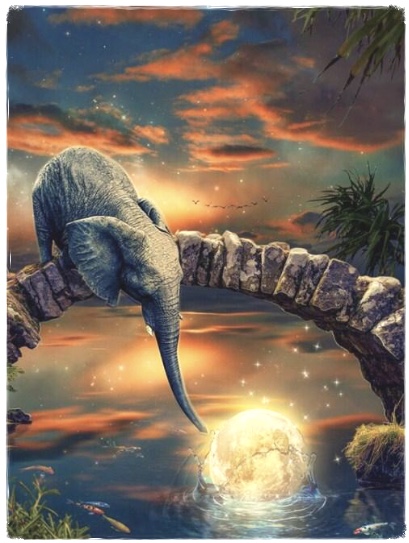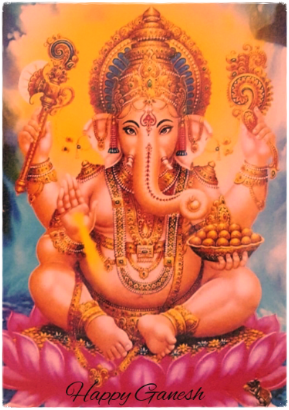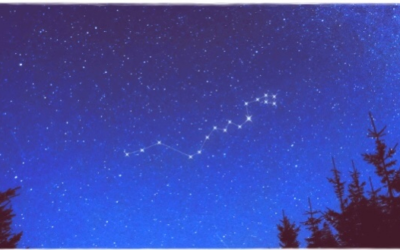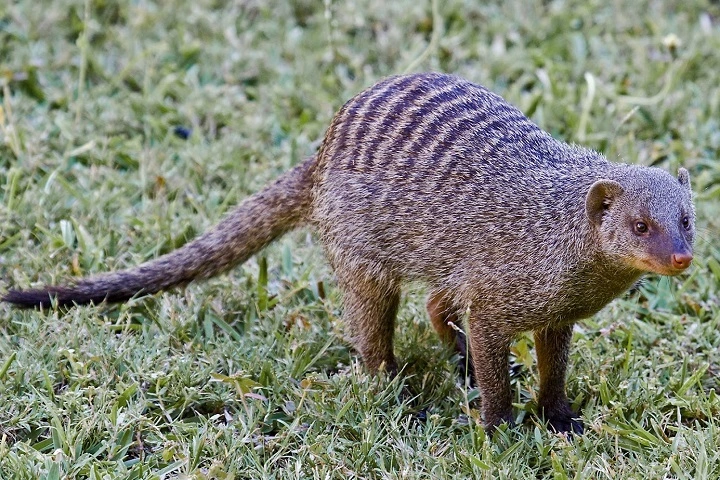#UTTARA_ASHADHA #NAKSHATRA

#UTTARAASHADHA NAKSHATRA
THE #STAR OF #IMPOSSIBLE #VICTORY

The full Moon of Saturday the 24th of July will be in the Nakshatra (lunar house) of Uttara-Ashadha. This will be the ritual day of Guru Purnima, which is a central day in the Tantric calendar of celebrating and honouring the teachers and elders who carry sacred wisdom.
This lunar junction of the Guru meets us annually when the Moon is in the star of Uttara Ashada. A position of power that encompasses the vast array of universal spiritual forces.
The other major Tantric festival that occurs when the Moon is in Uttara Ashadha, that is worth mentioning here, is Dusshera.
This is the 10th and concludent night of victory after the 9 nights of the Goddess in the Navaratri ritual festival.
The Navaratri ritual festival links together all aspects of the feminine mysteries, by traveling through a spiritual story that traces the path of the Goddess and her many expressions. This point of multiplicity is greatly poignant to the energy of Uttara Ashadha as we shall consider in the next section below.
This star signifies hard-earned victory and accomplishment.
Its victory is one that comes through drawing all psychic and physical forces into focus.
In our daily lives, we regularly apply this principle of gathering a multiplicity of forces together towards accomplishing an activity.
For example, the act of just going shopping, draws together many forces towards the single end of acquiring groceries.
It encompasses a vast array of activities… from finding our hat and coat and putting on our shoes, to navigating the many aisles of a supermarket, to gathering the right ingredients for the cake we are baking.
This is a mundane example of an accomplishment that many of us might take for granted.
It has elements of the accomplishment of Uttara Ashadha in that it draws together many elements and abilities. In the case of Uttara Ashadha, all the universal powers and skills are drawn together unto the attainment of the greatest of all victories… which is the revealing of the sacred heart.
Uttara Ashadha is sometimes called the star of victory and accomplishment, this is the wish and desire of this Star energy.
Ashadha is the urge and wish that focuses on the victory.
The god or gods that dwell on this Nakshatra are very interesting when considering the nature of the energy that this star carries to us.
The god of this star is Vishwadeva, who is not a singular being, but rather the collection of all goddesses and gods.
The Vishwadeva(s) is/are the collective of all the goddesses and the gods.
They are nourished by, and in turn nourish this star through the reflective lunar mediary of the Moon.
Vishwa literally means all and everything. Vishwadeva is the ultimate plurality of all sacred celestial beings. This multiplicity is the nature of the far-reaching force that is delivered by this Nakshatra.
It is also of note that some Puranic writings highlight a specific number celestial gods who are also called the Vishwadevas.
These 10 Vishwadeva deities and are the 10 qualities of Uttara Ashadha.
Vishwa is a word that implies multiplicity, interestingly, there is no one unanimous account of what the Vishwadeva really is. Some accounts single out a specific number of celestial deities, some accounts signify all deities, while some Mantras and accounts acknowledge all Devas and Asuras as coming under the title of Vishwadeva. What is unanimous in all accounts, is the idea of multiplicity and the conjunction of many forces.
And so, #Vishwadeva is the god of this Nakshatra, as we have seen, it can be taken to mean the conglomerate of all #goddesses and #gods and even #Asuras, but it can also be taken to mean 10 specific deities who carry the traits of Uttara Ashadha.
Sometimes an additional 2 Vishwadeva deities are also given, but we will highlight 10 for now.
Let us list the qualities of the wisdom of this Nakshatra, by naming the 10 Vishwadeva’s, and consider the 10 wisdom qualities that the Nakshatra of Uttara Ashadha represents and transports.
1) Vasu is fullness, expansiveness, illumination and brightness. This is wisdom in a broad sense. Wisdom that encompasses all things. It is a wisdom that is both elevated in metaphysical principles, but equally, it is a wisdom that is able to articulate on a street level. A wisdom that is able to touch and make contact with any arena of life. This is a totally non-exclusive quality to put it in a nutshell.
SATYA
2) Satya is truth and reality without sentiment or bias or restriction to any singular perspective.
Again, it carries the fullness and broadness of the previously highlighted Vasu quality. And because of this vast perspective, it is able to see the wide picture of reality in which all perspectives are at once acknowledged. This is the quality of not leaning towards any particular side. It is a quality of not escaping reality through any drama, distortion or sentiment.
KRATU
3) Kratu is focus of intention and will. This is the measured expertise that knows how to apply just the right amount of exertion. It is the focus that has forbearance and a deep intelligence, measurement and strategy. Kratu feeds its own certainty. Once it has considered the best angle of action and is certain about its course, it will approach its action with the quality of a charging elephant that will attempt to go through everything with unwavering persistence and urge.
DAKSHA
4) Daksha is skill, it is geometry and dexterity, it is a subtle creative vision that is able to link all things together into inner and outer harmonious forms. This is the skill of ritual, the ability to cloth metaphysical realities in tangible form. This is the skill of Tantra.
KAALA
5) Kaala is Time. It is the power to have the awareness of the reality of time in the phenomenal world, and at the ‘same-time’ it is the quality and power to be able to go to that plane of reality which is beyond the constraints of time.
Interestingly, Kala pronounced with the shortly accentuated ‘A’, means artistry, an artistry with a love for carefully detailed beauty. This is the artistry that comes from timing. Timing and rhythm are like the forms in which beauty is distilled, refined and expressed.
KAAMA
6) Kaama is desire, it is the urge of the soul, the unstoppable wish and hope (remember that Asha in Ashadha means urge and hope) Dha means wealth, this is the victory of desire. Not necessarily the fulfillment of desire as one is apt to think. But rather, to be possessed of the secret urge is the wealth itself here.
Kaama is the root power behind all desire, it is the spiritual longing and wanderlust that underlies all desires. Pure desire, if you will.
DHRTI
7) Dhrti is concentrated ruthless firmness and focus, this is the focused shot of the arrow. It is the ability to hold to a thing with full psychic involvement and endurance and patience. This is a quality of a healer and a Tantric magician, who focuses upon a thing and therefore manifests it, through their sheer Shakti of focused power.
KURU
8) Kuru is ancestral power, it is the strong relation to the realm of the ancestors. It is a spiritual sensitivity that at once lives in the manifest world, while at the same time being aware of the subtle movements of the inner planes. Kuru is to see the multi-dimensional interrelationship between matter and ghost, or spirit and body. The word Kuru is derived from the root Kri, which means to do or to act. Our actions carry power when they are related to our roots. When the acknowledgment of our roots and heritage informs our action, then it is truly potent.
Kuru then is connected to actions of healing ancestral imprints, so as to potentise and bring healing depth to our action.
PURURAVAS
9) Pururavas is abundance, broadness and generosity. The generosity of Pururavas is the kind that comes from a trust in the invanquishable and self-perpetuating well-spring of the heart. Pura means fullness it is to be remembered. The quality of Pururavas is that it’s not afraid to take risks or to lose. There is a deep trust that beneath any apparent loss and failure, is am inexhaustible wellspring of reserve life power. Pururavas is on the way to Madravas because of this fearlessness and trust in life force.
Generosity is not just a saintly virtue. It is a natural quality of the wisdom principle of ever-fulfilling a inexhaustible force. When we move away from the inexhaustible force of nature, we simply become exhausted. Pururavas is natural power that is effective because it burns like a steady flame, we could liken this to the endurance of an elephant that knows deeply about the wise handling and distribution of its life-force.
MADRAVAS
10) Madravas is natural power and joy of heart. It is accomplishment and the celebration of the freedom of the sacred heart. We are here dealing with a joy that is not dependent on any condition or form of entertainment. It is an inner natural power of spiritual essence that is not obscured by any hint of Ahamkara
So as we have now seen, The Nakshatra of Uttara Ashadha draws from a wide array of universal forces.
This star brings together the collection of a vast array of attributes. Let us say that it is the star that possesses the celestial toolbox, and has access to the broadest and most diverse range of spiritual instruments.
THE CELESTIAL TUSKS
The two twin stars of Ashadha are represented by Yogins as the elephant tusks of the celestial realm.
Uttara Ashadha is the matured elephant power that represents the full potential of grounded celestial forces in an earthly sense.
The Yogins connect to, and invoke the penetrating force these dual astral-tusk-points of energy, in rituals where Uttara Ashadha is worked with.

#Ganesh is the grand Chakravatin, which means he is the earthly foundation structure upon which all the other Chakra spin.
Ganesh and all creatures that have #tusks are connected to Uttara Ashadha Nakshatra. The tusk obtrudes beyond the sphere of the body towards the sphere of vision… in a similar way that horns do.
This is the star of focused victory. A focus sharply focused with a penetrating sharp tusk like urge of vision.
The tusk of Uttara Ashadha points – through its focus – towards a victory to which it is very close. Remember Uttara means mature, and the wise force of maturity is implicit here.
This star has the celestial blessings of its ruling deity, which as we have seen, is in fact the collective of all goddesses and gods, or alternatively, are highlighted as a group of the 10 qualities of wisdom.
This is indeed a heavy Nakshatra, possessed of the force of wisdom, we could say the heaviest.
It is like the weight of Ganesh, the elephant god who sits at the very foundation of the Chakras. It is the very weight of deep Saturnian wisdom in the cavern of the soul.
Uttara Ashadha is the focus of celestial forces into the vessels of earthly being. It deals with bringing together the most celestial with the most earthly, as we shall soon see in the next section.
The symbol of this lunar house is a tusk. Indeed, the energy that this Nakhatra imparts has the ability to bring us the tenacity of teeth and bone. The elephant and other tenacious creatures with tusks are linked to this Nakshatra.
Uttara-Ashadha is often considered to be the 21st Nakshatra. This is interesting when we consider that the number 21 is sacred to the Ganesh, the god with the elephant head.
The number 21 further links Ganesh to Nakshatra.
Ganesh rituals are well-known to involve 21 offerings along with the chanting of his 21 names. Ganesh as well as many other deities – as we shall see – are linked to this Nakshatra.
DUAL SINGULARITY OF FOCUS
Big obstacles are overcome by focused force and endurance – is the teaching of this Nakshatra, focus being the operative word here.
Uttara Ashadha is ruled by Surya (the Sun) and the quality of this Nakshatra is the transmission of powerful burning solar force through the mirror of the Moon.
Where an object meets the sun, there is a shadow, to take away the shadow is to take away the object.
Uttara Ashadha is certainly singularity of focus, but the paradox is that it’s singularity is aware of the multi-layered dualities of life. The dualities of life can be perceived as a singularity, for example, when the principle of sun and shadow are taken together. Sun and shadow are a unity when the object is in the picture, take away the object, and we have duality and endless metaphysical abstractions only. The object can’t be taken out of the picture if reality is valued.
The two tusks of the elephant bring together dualities by the space of life between them.
In the next concludent section of this text, we shall take a look at a spiritually cosmological teaching story that highlights the dualities of the tusk that saved the earth.
Uttara means mature and Ashadha implies a victory that is eternal.
But more accurately, it is the desire and urge to reach that victory that this star presents.
This star moves one towards victories by its power of enduring focus and discipline. It brings all seeming dualities and forces together in a single point. Or let us rather say, two unified points, like the tusks of an elephant.
The wisdom that Uttara Ashadha Nakshatra brings to us, is a wisdom that is aware of the dualities of light and shadow upon all its octaves.
To understand and know a thing comes through understanding and knowing it’s opposite.
To truly see the revealed, is to acknowledge and be aware of the unrevealed half.
Focus is a quality where all our powers are beamed in one direction and one direction alone.
Tantra is but the art and science of focus, ritual is focus.
Extraneous expenditure of our life forces must be reigned in and harnessed towards the most needed point in the path of our destiny, if we are to receive the teaching of Uttara Ashadha.
Uttara-Ashadha gives the teaching of enduring focus.
As already outlined, its focus is singular and unwavering – this is the quality of the Guru.
The Guru is an uncompromising force that endures in the vision for the very deep and enduring truths.
Guru Purnima is an age-old festival Uttara Ashadha Moon festival that honours the Guru.
In a world of beliefs opinions, likes, dislikes, dualistic information and endless modes of self-expression of all of these, we risk the very opposite of what Uttara-Ashadha wishes to show us.
If we spread our energies wide and thin, we risk dispersing our psychic spiritual power. But at the opposite spectrum, if we gather our forces together in concentrated unity and singularity of urge, we bring all the celestial forces to one point. This is the secret of communing with Vishwadeva.
It means to open ourselves to all the forces by maintaining a seat of power.
Like being in an observatory or a planetarium that sees all the multitudinous revolutions of realities orbiting the spirit that we are.
Uttara-Ashadha is the very opposite of light dispersing action. Guru is an adjective that means heavy, who is just like the elephant energy, that is the prominent earthly expression of the weight of this Nakshatra.
Just like the weight of memory possessed by the Elephant that never forgets… Uttara Ashadha gives power to mind and memory.
Heavy weighted enduring focus is given to us when the full Moon is in this lunar house.
When the full Moon meets this Nakshatra, it presents the gift of its qualities to us on earth.
We will open up in ritual to invoke and receive the lunar emanations of Uttara Ashadha Nakshatra.
THE POWER OF THE EARTHLY TUSK
Varaha is the Boar headed earthly deity of mighty tusk, who carries the lesson of Uttara Ashada very well, so let us consider it here.
The story of Varaha tells of how he saved the earth from drowning in the subterranean waters when the Asuric forces attacked and threatened to ruin the earth.
Varaha and Bhumi (Earth Goddess) are lovers, together they birthed Mangala (Mars). Varaha saved Bhumi from drowning in the subterranean waters by lifting her in his tusks.
The impossible concentration it took Varaha to lift the earth out of the enveloping waters in which she was drowning, required the exclusion of all else but the matter at hand.
Or rather we could say, the matter at tusk – for Varaha hooked the earth in his tusks and carried her to safety.
Varaha presides over the Dhatu (physical element) of bone – this is the most hard of the Dhatus, and symbolises strength solidity of focus.
Varaha, in saving the earth, drew together all skills and abilities towards the single end.
The tusks are sharp and – being two – represent the dualistic forces concentrated into one action to achieve the victory that it is our Karma to accomplish.
What that victory is, is a personal journey to discover.
The discovery and realisation of our destiny requires dualistic forces to come together. This is the focus of Varaha, he is a most mighty deity… mighty of focus.
#Uttara-Ashadha can be seen to signify the imminent victory of the very real and deep pressing matters. Its imminent victory comes through the application and uniting together of all extraneous forces and subtle energies.
Its victory can’t be assumed without endurance and determined clarity of focus.
This endurance and determined clarity of focus is a Saturnian quality.
The story of Varaha saving the earth from drowning in the waters holds a Saturnian code within it. The Saturn ruled constellation of Capricorn is known as Makara to the Yogins. This is the constellation of the crocodile, who gives us the wisdom and power to articulate deeply between the dualities of its realms of mastery – water and earth.
Just as the mighty and fearlessly focused Varaha and Bhumi reveal the initiation of earth and water through the power of the tusk.
https://www.ancient-tantra.com/61-uttara-ashadha/









